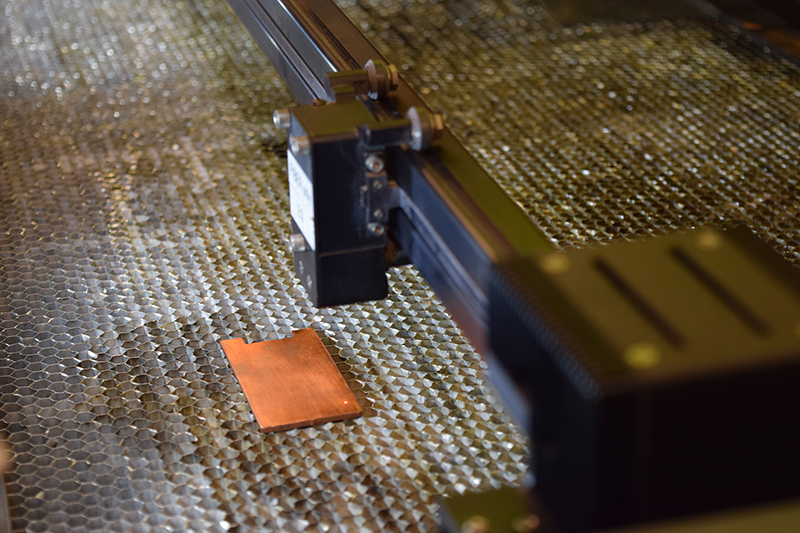Apr 10 2020
Bacterial pathogens are known to survive on surfaces for many days. What if doorknobs and other frequently touched surfaces could immediately destroy them?
 A laser prepares to texture the surface of copper, enhancing its antimicrobial properties. Image Credit: Purdue University photo/Kayla Wiles.
A laser prepares to texture the surface of copper, enhancing its antimicrobial properties. Image Credit: Purdue University photo/Kayla Wiles.
Engineers from Purdue University have now developed a new laser treatment method that can possibly transform any metal surface into an instant bacteria killer—by simply giving a different texture to the surface on the metal.
The scientists have reported this laser technique in a study published in the Advanced Materials Interfaces journal, which demonstrates that this method allows copper surfaces to instantly destroy superbugs like MRSA.
Copper has been used as an antimicrobial material for centuries. But it typically takes hours for native copper surfaces to kill off bacteria. We developed a one-step laser-texturing technique that effectively enhances the bacteria-killing properties of copper’s surface."
Rahim Rahimi, Assistant Professor, Department of Materials Engineering, Purdue University
However, the laser technique is yet to be customized for destroying viruses, like the one responsible for the recent COVID-19 outbreak, which are relatively smaller when compared to that of bacteria.
But since the time this work was published, Rahimi’s research team has started to test this laser technology on the surfaces of other polymers and metals that are used to inhibit the potential growth of bacteria and the formation of biofilms on medical devices like wearable patches for chronic wounds or orthopedic implants.
According to Rahimi, giving an antimicrobial surface to such implants would not only prevent the spread of infections but would also prevent the emergence of antibiotic resistance, because antibiotic medications would not be required to destroy the pathogens from the surface of an implant.
The laser technique could be suitable for metallic alloys that are already known to have antimicrobial characteristics.
Metals like copper usually have an extremely smooth surface, which renders it hard for destroying the pathogens through contact.
The method devised by Rahimi’s research team utilizes a type of laser to produce nanoscale patterns on the surface of the metal. These tiny patterns create a rough texture that boosts the surface area, enabling more chances for the bacteria to strike the surface and disintegrate on the spot.
Earlier, scientists had employed different nanomaterial coatings to improve the antimicrobial characteristics of metal surfaces, but such coatings are likely to leach off and can prove dangerous to the environment.
We’ve created a robust process that selectively generates micron and nanoscale patterns directly onto the targeted surface without altering the bulk of the copper material."
Rahim Rahimi, Assistant Professor, Department of Materials Engineering, Purdue University
Rahimi’s laboratory creates biomedical devices and novel materials to tackle health care problems.
The laser-texturing also imparts a dual effect—that is, this method enhances direct contact and also renders the surface highly hydrophilic. In the case of the orthopedic implants, these surfaces enable bone cells to bind more robustly, enhancing the implant’s ability to merge with the bones. Rahimi’s research team noted this effect in the fibroblast cells.
Since the laser technique is simple and scalable, the scientists assume that it could easily be employed in present-day processes used for manufacturing medical devices.
The study was partly funded by Purdue University’s School of Materials Engineering and the Wabash Heartland Innovation Network. The study was conducted at the Birck Nanotechnology Center at Purdue University’s Discovery Park.
Treating Metal Surfaces to Kill Bacteria
Bacterial pathogens can live on surfaces for days. What if frequently touched surfaces such as doorknobs could instantly kill them off? Video Credit: Purdue University/Erin Easterling.